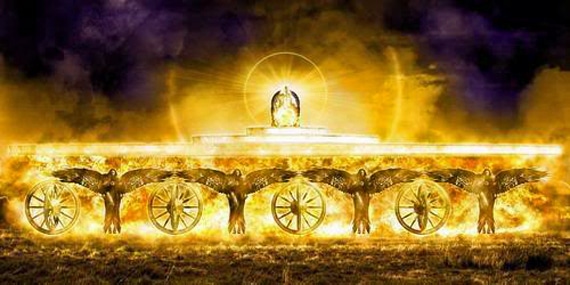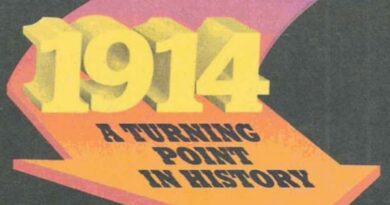The Immutable Good News
The good news or gospel of the kingdom of God began to be preached nearly two thousand years ago, when John the Baptist appealed to his fellow Israelites to “repent, for the kingdom of heaven is near.” (Matt. 3:2) John’s ministry served to prepare the hearts and minds of people for the promised kingdom of God and introduce them to their promised messiah, Jesus Christ. Later, when Jesus learned that John had been imprisoned, he went north to the territory of Galilee and echoed John’s plea to the nation: “Repent for the kingdom of heaven is near.” (Matt. 4:17) Jesus’ itinerant ministry featured the kingdom theme: “Jesus went throughout Galilee, teaching in their synagogues, preaching the good news of the kingdom, and healing every disease and sickness among the people.” (Matt. 4:23) The kingdom of God was the central theme of Jesus’ teaching:
According to all three Synoptics, the kingdom of God was the central theme of the preaching and teaching of Jesus. The phrase occurs fourteen times in Mark, thirty-two times in Luke, but only four times in Matthew (12:28; 19:24; 21:31, 43). In its place, Matthew substitutes “the kingdom of heaven.” (Lit. “The kingdom of the heavens,”) Although dispensational theology has customarily made a theological distinction between these two terms, the simple fact is that they are quite interchangeable (cf. Mt. 19:23 with v. 24; Mk. 10:23). In Jewish rabbinic literature, the common phrase is “the kingdom of the heavens.” In Jewish idiom, “heaven” or similar term was often used in place of the holy name. (See Lk.15:18; Mk. 14:61) — International Standard Bible Encyclopedia. Vol. 3, p. 24.
In regard to that kingdom, it should be noted that the correct phrase is “the kingdom of heaven,” not “the kingdom in heaven.” In other words, there is a kingdom of God — a kingdom that functions under his auspices and control, that will ultimately triumphant over all of God’s enemies and restore his sovereignty over the earth. The ruling monarch of that kingdom is the Lord Jesus Christ. Concerning his rule we are told, “He must reign until he has put all his enemies under his feet. The last enemy to be destroyed is death.” (1 Cor. 15:25, 26) However, this ultimate, far-reaching effect of the kingdom of God was not fully appreciated by its initial hearers.
The preaching about that kingdom began in God’s covenant nation of Israel, chaffing under the yoke of Roman rule. The nation had not known freedom from foreign rule from the time of their overthrow by the nation of Babylon in 586 B.C. Successive world powers — Babylon, Medo-Persia, Greece and now Rome — had dominated the nation for more than six hundred years. While God had enforced the consequences for Israel’s rebellious and idolatrous behavior by having them taken off their land and carried into bondage, he also gave them the hope of a future restoration. So when Jesus incorporated the language of restoration hope as part of the kingdom message, it ignited the flame of expectancy in the hearts of many.
In his hometown of Nazareth, Jesus entered the synagogue one Sabbath day and read the following text from the prophet Isaiah to those assembled there: “The Spirit of the Lord is on me, because he has anointed me to preach good news to the poor. He has sent me to proclaim freedom for the prisoners and the recovery of sight for the blind, to release the oppressed, to proclaim the year of the Lord’s favor.” After saying these things, he added: “Today this scripture is fulfilled in your hearing.” (Luke 4:18, 19, 21, NIV).
Of course, those drawn to Jesus and his kingdom message assumed that he would reestablish Israel’s monarchy at that time. He was a son of David’s house, to whom God had promised a dynasty of kings that would never end. (2 Samuel 7:11-16) When the last monarch of David’s line, king Zedekiah, was removed from the throne, God, speaking through the prophet Ezekiel, declared: “A ruin! A ruin! I will make it a ruin! It will not be restored until he comes to whom it rightfully belongs; to him I will give it.’” (Ezekiel 21:27, NIV) Many believed the time had now arrived for that restoration and that Jesus would sit on David’s throne in Jerusalem. In fact, his mother Mary had been told by the angel Gabriel that her son would be great and that “God will give him the throne of his father David.” (Luke 1:32)
It was not understood that before Jesus could be enthroned as king it would be necessary for him to first die as the “Lamb of God.” (John 1:36) As the apostle Paul would later explain in considerable detail in Romans chapter five, it was necessary that Jesus give his life as a ransom to redeem fallen humanity from the consequences of sin caused by Adam’s fall. (Mark 10:45) The death of Jesus was a crushing blow to the kingdom hopes of his disciples. But their hope was restored when they became convinced of his resurrection. He made a number of appearances to them in the short time before he was taken up to heaven to sit at his Father’s right hand. The disciple Luke makes mention of these post-resurrection experiences and says, “He appeared to them over a period of forty days and spoke about the kingdom of God.” (Acts 1:3) So we learn that the kingdom theme continued to be on the lips of Jesus after his resurrection. On one such occasion he was asked: “Lord, are you at this time going to restore the kingdom to Israel?” In answer Jesus said, “It is not for you to know the times or dates the Father has set by his own authority. But you will receive power when the Holy Spirit comes on you; and you will be my witnesses in Jerusalem, and in all Judea and Samaria, and to the ends of the earth.” (Acts 1:6-8, NIV)
Despite this clear directive, many have ventured into this forbidden area and have presumptuously and triumphantly preached their “times and dates,” regarding the kingdom of God. Unfortunately, many innocent people have been duped into believing such things to their ultimate disappointment and sense of betrayal. All of this could have been avoided if people had simply listened to what Jesus had to say about the matter. Despite what the Lord said, many have attempted to decipher certain signs as indicating the nearness of his return and kingdom rule. Part of the problem is how the contents of Matthew, chapter 24 have been misinterpreted, not just by Jehovah’s Witnesses, but by evangelicals as well. Jesus had just told his disciples that the temple in Jerusalem being elaborately renovated by king Herod would be destroyed completely. Shocked by such a prospect the disciples inquired as to when this would happen. However, in phrasing their question they asked other questions: “‘Tell us,’ they said, (1) ‘when will this happen, and (2) what will be the sign of your coming and (3) the end of the age?’” (Matt. 24:3) Apparently, the disciples lumped the three questions together because they assumed they would all take place simultaneously.
Jesus answered their questions in the remaining verses of Matthew, chapter 24. The problem in understanding his answer rests in properly separating his words and applying them to the right question. As regards the first question relating to the destruction of the temple, Jesus gave a detailed answer as to what to expect in the years leading up to that destruction, which occurred in A.D. 70 by the Roman legions. When we compare Matthew 24 with Luke 21, we find a number of specifics that enabled the disciples to discern the time and flee from danger. But when we come to the other questions about his return and the end of the age, we see something different. He said that the common events of history (wars, famines, earthquakes, etc.), would continue to the end of the age. These things were non-signs as regards the pinpointing of his return and the end of the age. None of those things would provide a clue as to the nearness of Christ’s coming or the end of the age because they would be a common phenomena in every period of time. The disciples were warned not to respond to such non-signs, or get excited by some false prophet in regard to these things. To be sure, by the way these things are worded in Matthew and Luke it is not easy to determine what is being applied to each The wording presents certain knots that need to be untangled, so to speak. But those knots are untangled by what we are told regarding Jesus’ return and the end of the age.
The coming of the kingdom is associated in Scripture with the second coming of the Son of Man. These events come under the cloak of secrecy because they happen simultaneously. Concerning his return Jesus himself said, “No one knows about that day or hour, not even the angels in heaven, nor the Son, but only the Father.” (Mark 13:32, 33-37) The apostle Paul reinforced the sudden, unexpected nature of that event when he wrote: “Now, brothers, about times and dates we do not need to write to you, for you know very well that the day of the Lord will come like a thief in the night.” (1 Thess. 5:1, 2) So when Jesus said, “And this gospel of the kingdom will be preached in the whole world as a testimony to all nations, and then the end will come,” (Matt. 24: 14) he was not saying a new gospel of the kingdom was going to be preached — one that identified the very generation that would witness its coming. No, he was merely saying that in addition to all the other factors he spoke of, his disciples would continue to preach the immutable good news or gospel of the kingdom. That was the thrust of Jesus’ remarks in Acts 1: 8, “you will be my witnesses… to the ends of the earth.” Jesus’ faithful disciples were to be found faithfully preaching the good news of the kingdom. They were not to be found trying to uncover divine secrets regarding the times and dates God has reserved for himself.
After receiving power on Pentecost day, the fellowship of believers underwent a profound change in understanding regarding the coming kingdom of God. The new covenant arrangement was now in effect and a new creation appeared. The kingdom hope was dramatically enriched by such things. The kingdom had both a here and now aspect as well as a then and there aspect. Already, Christians were to think of themselves as glorified with the enthroned Christ at God’s right hand. (Eph. 2:6) This new, exalted relationship is thoroughly presented in the early chapters of Paul’s letter to the Ephesians. He summarizes that wonderful gospel in chapter 4: “There is one body and one spirit — just as you were called to one hope when you were called — one Lord, one faith, one baptism; one God and Father of all, who is over all and through all and in all.” (Eph. 4:4-6)
In the above words the apostle Paul outlined the gospel that was to be preached until the end of the present age. Concerning this wonderful reconciliation with God through Jesus Christ and the “one hope” it offers, Jude wrote: “Dear friends, although I was very eager to write to you about the salvation we share, I felt I had to write and urge you to contend for the faith that was once for all entrusted to the saints.” (Jude 1:3) The New World Translation reads, “I found it necessary to write you to exhort you to put up a hard fight for the faith that was once for all time delivered to the holy ones.” All that was delivered to the holy ones in the first century constituted the good news that was to be joyfully preached and lived until the end of the present age.
That gospel cannot be added to or subtracted from, although efforts were made from the beginning to do so. Early on, certain Jewish adherents of the Law, who accepted Jesus as the messiah, would have Gentile believers be circumcised as necessary for salvation in Christ. When the apostle Paul learned of this he was furious. He wrote: “I am astonished that you are so quickly deserting the one who called you by the grace of Christ and are turning to a different gospel — which is really no gospel at all.” (Gal. 1:6, 7) This “different gospel” did not deny Christ, it only added the need of circumcision. Yet, Paul said it was “no gospel at all.” Abraham had received circumcision as a sign of the covenant between himself and Yahweh God. (Gen. 17:9-14) Moreover, every male descendant of Abraham was to have this ritual performed. It was styled as an “everlasting covenant,” and had been faithfully practiced for two thousand years. Circumcision was commanded in the Law of Moses, but Paul says to add it to the gospel of Jesus Christ was deadly. (Lev. 12:1-3) He went so far as to say, “Mark my words! I, Paul, tell you that if you let yourselves be circumcised, Christ will be of no value to you at all.” (Gal. 5:2) Strong words, these, but they underscore the danger of adding to the gospel. In the strongest possible terms Paul declared: “But even if we or an angel from heaven should preach a gospel other than the one we preached to you, let him be eternally condemned! As we have already said, so now I say again: if anybody is preaching to you a gospel other than what you accepted, let him be eternally condemned.” (Gal. 1:8, 9)
Against this inspired testimony what are we to say to someone who introduces a new hope wrapped up in a new gospel? Based on what we read in the Scriptures it must be rejected out of hand as a false gospel — no gospel at all. The biblical good news is an immutable gospel; it cannot be changed. To add to it or subtract from it is to destroy it. As for the two flocks of sheep Jesus alludes to in John, chapter 10, these clearly represent the Jewish flock which was penned within the Mosaic Law Covenant and later joined by “other sheep” which represented non-Jew- ish, or Gentile believers who were never in the Jewish sheepfold. The function of the Holy Spirit led to the breaking down of the wall that separated these two ethnic societies. (Eph. 2:11-18) In this way believing Jew and believing Gentile became one flock, one shepherd, just as Jesus had foretold. (John 10:16) They came to share in the “one body, one Spirit, one hope (not two), one Lord, one faith, one baptism, one God and Father of all.” (Eph. 4:4-6) It is this good news of the kingdom that would continue to be preached until the end of the present age. It is this good news that I have received in faith and share with others. There simply is no other.
_________
Image: God’s Throne (spraypainting graffiti), Jason Hardin, Jun/2012.


